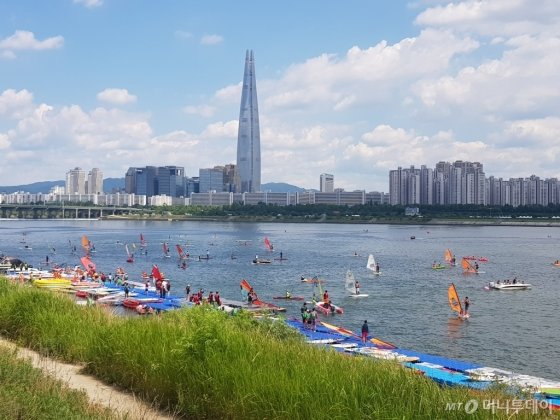Within a bustling city like Seoul, the few places untouched by the pernicious hand of human activity seem to be those rendered inaccessible by accident of their geography: mountains, lakes, and rivers. And it is ironic, though reasonable, that those places relatively unaffected by collective human development are often the preferred locales of community gatherings.
It is perhaps no wonder, then, that a city with enough mountains to warrant their own Wikipedia page [1] is also one with a high density of parks (also with their own equally long Wiki page [2]), nature trails, and other scenic meeting points, as well as a population that consistently names hiking as its favorite leisure activity [3]. Likewise, it is not surprising that, according to a 2009 survey of Seoul residents, the most beautiful such gathering place (second only to Namsan Tower, incidentally built atop a forested mountain) is considered to be the Han River (漢江/한강) [4], a long stretch of water relatively uninterrupted by the city structures that have largely chased away the flora elsewhere in Seoul.
No surprise indeed for anyone who has visited this river, a busy but beautiful activity center that stretches 500 kilometers from Taebaek (太白/태백) in central Korea to the Yellow Sea in the west [5] and features banks in Seoul dotted with parks, athletic fields, and walking and bike paths. Narrated ferry tours can be taken from a few spots along the river during the day and into the night [6]. Sports teams, including Seoul’s international Ultimate Frisbee league [7], hold practices and events along various points of the river, and organized swims, such as the annual “Handicapped Hangang Swim Festival” [8] and the “Hangang Crossing Festival” [9] are also common.
By serving as the site for so many different community activities, the Han embodies the possibility of connection among the otherwise separate individuals who share it. With its twin sources from the South Han River (南漢江/남한강) and North Han River (北漢江/북한강) and a locked-off estuary located between the two warring Koreas [10], however, it might also stand as a tragic reminder of the arbitrary divisions that can drive otherwise connected people apart.
Just as the Han River’s geography serves as a reminder of the historical ties between North and South Korea, its character-based name also represents the historical links between South Korea and China, though perhaps not in the way that some may assume. The Han 漢 (汉) of “Han River” is a Chinese character of multiple meanings, one of which refers to the ethnic Chinese nation “Han” as seen in the names Hànzú 汉族 (Han people) and even Hànyŭ 汉语 (synonym for spoken Mandarin Chinese). The name Hangang may thus be misinterpreted to imply that the Han River, as well as its associated 漢城 (Hànchéng, a name Seoul used until the Korean government officially changed its characters to Shóuĕr 首尔 to avoid this confusion [11]), somehow belongs to, or once belonged to, China. An older reading of the character—and more likely the one intended when it was first applied—is, however, the meaning “large,” which is generally rendered in modern Chinese as 大and, correspondingly, in Korean as 대 (dae). A connection between these two interpretations may also be seen in the old name of the Korean city Daejeon [12], which can also be called 漢밭 (“Hanbat” for “big field”), a name equivalent to the currently more common 大田 (the modern “Daejeon,” which also means “big field”) [13].
The Hangang might serve as a powerful reminder not only of the important relationships among different peoples—the various residents of Seoul, North and South Koreans, Koreans and Chinese—but also of that between people and the environment. In the seventies and eighties, blighted by South Korea’s rapid and reckless economic development, the Seoul leg of the river was apparently so dirty that it was impossible to catch the fish that had once thrived in its waters. A cleanup operation in time for the 1988 Olympics apparently ameliorated the condition enough to justify such events as the aforementioned swim festivals [14], but the river still shows signs of pollution, with toxic chemical concentrations that increase along its westward flow. Correspondingly, pictures of dead fish littered the front page of a Donga Ilbo published in 1988 following a flurry of waterfront construction in Singok and Jamsil even after the supposed cleanup in the eighties [15], and visual and numerical evidence of pollution continues to surface in the media even today, much to the chagrin of naturally concerned residents [16].
The Han at once links one people and divides two nations, symbolizes shared regional origins and epitomizes our undeniable association with a common natural habitat. Within this ever-shifting body of water lie ten-thousand thousands of contradictions, histories, and possibilities, the surfacing coalescence of which is ultimately determined by the perspective of the individual observer. Though we might all peer into the same body of water, we each see different reflections of a common landscape, creating a singular personal experience that can be perceived only indirectly, retrospectively, and ultimately individually.
Should you, in turn, look into this paradoxically tranquil yet busy, conjoining yet divisive, river in Korea, what would you find?
This article was originally written for The Silk Road Project, now I Dig Culture, an international media channel that explores human cultural diversity and exchange.

